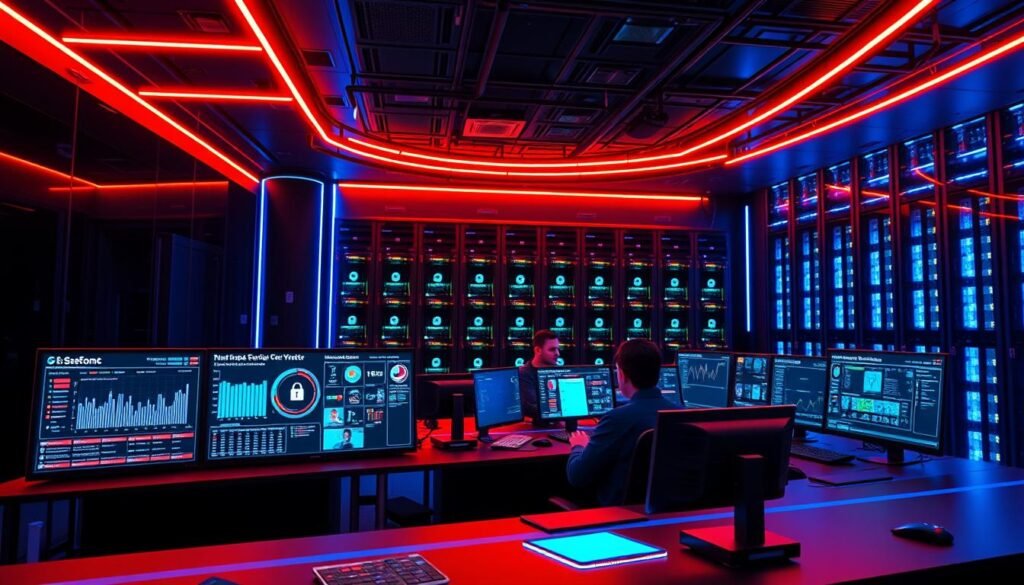What is Security Automation? Security automation is the process of using software and automated workflows to detect, investigate, and remediate cyberattacks with minimal human intervention. By replacing manual steps with automation, organizations can cut breach costs, speed up response times, and improve overall security efficiency.
security automation uses software to detect, investigate, and remediate cyberattacks with minimal human steps. When fully deployed, it can cut breach costs dramatically and boost analyst efficiency.
The approach ties together SIEM, SOAR, XDR, EPP, firewalls, ticketing, sandboxes and directory services to unify data and orchestrate end-to-end workflows. Standardized playbooks make responses predictable, auditable, and faster to execute.
Leaders see clear outcomes: quicker detection, lower mean time to respond, consistent operations, and measurable benefits. IDC found organizations using Red Hat Ansible Automation Platform realized major ROI and efficiency gains.
This Ultimate Guide will define scope, show key platforms and use cases, and map practical steps for any U.S. organization to scale defenses while letting teams focus on complex threats.
Key Takeaways
- Automation systematizes repeatable processes to reduce time-to-action and human error.
- Integrated systems unify data and coordinate responses across tools.
- Standardized playbooks deliver predictable, auditable outcomes at scale.
- Measured results include lower breach costs and higher analyst efficiency.
- Adoption lets teams concentrate on complex threats while platforms handle routine tasks.
Security Automation in 2025: Why It Matters Now
As threats grow in scale and complexity, automated processes let organizations act faster without expanding headcount.
Rising attack volume and talent shortages have moved security automation from optional to essential. Teams face more signals, tighter budgets, and larger hybrid estates. Automation shortens time-to-detection and time-to-response so analysts can contain incidents before they escalate.
Unified platforms collect data from endpoints, cloud, and networks. This approach reduces tool sprawl and lets a single playbook drive consistent actions across systems. Automated enrichment and correlation turn raw telemetry into prioritized alerts.
Cost savings come from fewer manual tasks, reduced errors, and predictable operations. Leaders see measurable benefits: lower operational costs, faster incident handling, and improved reporting on risk and continuity.

| Outcome | Metric | Benefit |
|---|---|---|
| Faster containment | Time-to-response reduced by 40%-60% | Less dwell time, fewer escalations |
| Operational efficiency | Analyst workload down 30%-50% | Reallocate staff to high-value work |
| Predictable audits | Standard playbooks across platforms | Consistent compliance and reporting |
Analysts remain central for judgment and escalation while automation handles routine triage. Adopted thoughtfully, this approach moves teams from reactive firefighting to proactive defense. Later sections cover platforms, rollout steps, and best practices tailored for 2025.
What is Security Automation? Core Concepts and Definitions
Software workflows let analysts focus on judgment while routine triage runs automatically across systems.
Security automation is the disciplined use of software-driven workflows to detect, investigate, respond to, and remediate threats across an organization’s full IT environment. It connects network, endpoint, cloud, APIs, and containers so repeatable tasks run consistently and with fewer errors.
SIEM plays a central role by aggregating and normalizing high-volume logs. This preserves data for investigations, powers analytics, enables detection content, and supports retrospective threat hunting.
From IT domains to coordinated workflows
SOAR platforms and playbooks translate detections into auditable actions. They coordinate tools, systems, and teams to scale incident handling while keeping governance and documentation intact.
| Concept | Function | Benefit |
|---|---|---|
| SIEM | Collects, normalizes, stores logs | Better detection and historical analysis |
| SOAR / Playbooks | Orchestrates responses across systems | Consistent, auditable remediation |
| Automation Scope | From event collection to remediation | Faster MTTR and reduced manual toil |

How Security Automation Works: From Detection to Response
Events stream in from diverse sources and get normalized so correlation can detect real threats quickly.
Event ingestion, normalization, and correlation
Data comes from endpoints, firewalls, cloud services, and apps. The platform normalizes formats, correlates signals, and enriches events with context.
This improves detection fidelity and reduces false positives. Enrichment adds threat intel, asset context, and user risk scores.
Automated workflows and playbooks
SOAR playbooks trigger on detections and execute sequenced steps that are versioned and auditable. Actions can be manual-gated for sensitive tasks.
Vulnerability scanning and prioritization
Continuous scans identify weaknesses, then risk-based prioritization creates tickets or applies patches automatically. Verification steps confirm fixes.
Incident orchestration and containment
Playbooks can isolate endpoints, revoke credentials, block domains, collect forensics, and notify stakeholders to speed response.
“Automated records and tested playbooks compress response time while preserving audit trails.”

| Stage | Action | Outcome |
|---|---|---|
| Ingest & Normalize | Collect logs and standardize fields | Better correlation and fewer false alerts |
| Playbook Execution | Run sequenced remediation steps | Consistent, auditable operations |
| Vulnerability Workflow | Prioritize, ticket, patch, verify | Lower mean-time-to-patch and risk |
Key Security Automation Tools and Platforms
A modern stack pairs log analytics, orchestration playbooks, cross-domain detection, and vulnerability prioritization to shrink response time.
Security Information and Event Management
SIEM collects system, application, firewall, and database logs. It normalizes fields, retains data for historic hunting, and runs content-driven detections across high-volume sources.
Security Orchestration, Automation, and Response
SOAR automates collection of alert-relevant data and choreographs multi-tool responses with low-code playbooks. Splunk SOAR is a widely used example that speeds investigations and preserves audit trails.
Extended Detection and Response
XDR correlates telemetry from endpoints, networks, and cloud. ML-based detection and automated actions help analysts resolve incidents faster and reduce user impact.
Risk-Based Vulnerability Management
RBVM aggregates vulnerability data and adds business context to prioritize fixes. That approach shortens mean-time-to-patch and mean-time-to-respond.
Unified Asset Inventory
A single inventory removes duplicates, resolves conflicts, and gives clear context for devices, applications, and services. This improves visibility and compliance reporting.

- Common actions: quarantine endpoints, block URLs, geolocate IPs, and search endpoint files.
- Integration breadth matters: firewalls, EPP/EDR, sandboxes, directory, ticketing, and SIEM working together increases coverage.
- Pick tools by ease of use, plugin ecosystems, and secure scalability to grow maturity incrementally.
Benefits and Business Outcomes for Security Teams
When processes run predictably, risk drops and teams regain time for strategic work.
Enhanced efficiency: Automated enrichment, triage, and response reduce manual toil and alert fatigue. Analysts spend less time on routine tasks and more on threat hunting and escalation. IDC reports a 27% improvement in team efficiency after standardizing on proven platforms.
Faster detection and MTTR: Correlated data and prebuilt playbooks speed accurate detection and containment. Faster cycles lower incident impact; detecting and containing within 200 days can save about $1.22M on average.
Scalability: Standard workflows extend coverage across networks, cloud, and endpoint devices without linear headcount growth. The platform approach lets an organization scale protections across diverse infrastructure and systems.
Cost-effectiveness: Fewer manual steps, reduced human error, and smarter resource allocation cut ongoing costs. Fully deployed automation can reduce average breach costs substantially—studies show up to a 95% reduction in some scenarios.
- Hardened operations: Consistent policy execution and auditable records support compliance and simplify audits.
- Organizational gains: Clear handoffs, better visibility, and improved collaboration between security teams and IT operations.
- Continuous improvement: Guardrails and training keep automation tools aligned with evolving practices and preserve analyst oversight.
“Automation shrinks attack windows, lowers successful breaches, and gives teams the time to focus on true risks.”
High-Impact Use Cases and Real-World Workflows
Operational playbooks turn raw alerts into fast, repeatable actions that reduce noise and speed response.
Threat detection, intelligence, and proactive hunting
Automated intelligence ingestion pulls feeds and enriches alerts so detection rules fire with context. That creates analyst-ready incidents and fewer false positives.
Prebuilt searches and scheduled data pulls support hunting. Analysts test hypotheses quickly across endpoints, logs, and cloud systems.
Automated incident management: triage, containment, and remediation
SOAR coordinates triage workflows that collect evidence, run verdict checks, and prioritize incidents. Policy-based containment can isolate endpoints, block URLs, or revoke keys automatically.
Remediation steps link to ticketing for accountability and include verification to confirm fixes completed.
Continuous compliance monitoring and reporting
Automated policy checks and configuration scans produce continuous evidence for audits. That reduces manual tasks and speeds reporting to stakeholders.
Quantifying cyber risk and prioritizing remediation
RBVM and a unified asset inventory map vulnerabilities to business context. That ranks fixes by impact and tracks remediation progress across the organization.
| Use Case | Action | Outcome |
|---|---|---|
| Proactive detection | Intelligence ingestion + enrichment | Higher-fidelity alerts, fewer false positives |
| Threat hunting | Prebuilt queries + automated data pulls | Faster hypothesis testing and discovery |
| Incident management | Automated triage + policy containment | Shorter time-to-contain and verified remediation |
| Compliance | Continuous checks + evidence collection | Simplified audits and lower manual workload |
| Risk prioritization | RBVM + unified inventory | Clear fix priorities and tracked remediation |
Feedback loops close the cycle: post-incident reviews refine detections and playbooks. Over time, the result is fewer escalations and clearer reporting for leadership.
Implementing Automation: From Requirements to Rollout
Start with clear metrics and a realistic plan to turn manual steps into reliable processes.
Establish needs: quantify daily alert volumes, false positives, and dwell times. List repeatable tasks that eat analyst hours. Tie targets to top business goals so every playbook maps to measurable value.
Define use cases: design playbooks that mirror real operations. Include approval gates, rollback steps, and verification checks. Prioritize low-risk workflows for early wins and fast feedback.
Vendor research and evaluation
Compare platforms for low-code playbook builders, plugin ecosystems, and proven deployment timelines. Favor cloud-first solutions for faster updates and lower maintenance.
Integration and rollout
Ensure connectors for SIEM, EDR/EPP, firewalls, identity, sandboxes, threat intel, and ticketing. Plan phased integration so systems stay stable while orchestration expands.
- Capture current alert loads and target outcomes before procurement.
- Map use cases to standardized workflows and test them in staging.
- Evaluate low-code builders, integration breadth, and support options.
- Adopt cloud-first for quicker iteration while meeting compliance needs.
- Build training and change management so teams adopt new processes confidently.
“Pilot low-risk tasks first, measure MTTR, false positives, and automation success, then scale with governance.”
Define KPIs and dashboards up front (MTTR, MTTP, false-positive rate, automation success/failure). Establish playbook governance with version control, testing, approvals, and documentation to keep systems auditable and teams aligned.
Challenges, Limitations, and Best Practices
Practical deployments expose people, cost, and governance issues that require careful planning and oversight.
Skills gap and over-reliance
Keep human judgment central
Many teams lack the experience to tune AI-driven playbooks. Pairing automation with focused upskilling keeps analysts in the loop for complex incidents.
Define clear role boundaries and approval gates so machines handle routine tasks while humans handle nuanced decisions.
Budgeting for total costs
Upfront licensing, integration, and implementation are only part of the bill. Ongoing maintenance, patching, and support add recurring costs.
Plan realistic budgets for tooling, staff time, and vendor support so operations stay sustainable.
Compliance and auditable responses
Automated steps must map to policy and retain logs for audits. Regular reviews ensure playbooks remain aligned with changing compliance rules.
- Prioritize high-impact tasks and start with low-risk playbooks.
- Document runbooks before converting them to automated workflows.
- Set human-in-the-loop thresholds and rollback plans.
- Run periodic tabletop exercises and audits to validate controls.
- Make training a continuous program tied to tool updates and practices.
“Treat automation as an operational aid, not a substitute for expertise.”
The Future of Security Automation: AI, ML, and Continuous Improvement
Adaptive systems tune workflows continuously, shifting playbook steps based on confidence and context.
AI-driven detection, predictive analytics, and adaptive workflows
AI and ML improve detection by analyzing vast amounts of event and telemetry data to spot subtle patterns and new threat tactics.
Models assign confidence scores and prioritize incidents so analysts see high-value work first. XDR and similar platforms leverage ML to trigger targeted responses automatically.
Adaptive workflows then change paths based on context, risk models, and user impact. That reduces false positives and speeds verified containment.
From exposure to impact: measuring outcomes and refining processes
Link exposure visibility to business impact by quantifying risk per asset and mapping fixes to priorities.
Measure outcomes with clear KPIs: incident reduction, time-to-remediate, and cost avoided. Use feedback loops to retrain models and update playbooks.
Governance stays central: human oversight, explainability, and audit trails keep automated decisions compliant and testable.
“When models learn from incidents, platforms act faster — but teams must test, document, and tune continuously.”
- Scalable data pipelines and model management support continuous learning.
- Cross-platform analytics centralize signals from networks, endpoints, and cloud infrastructure.
- Invest in skills to interpret intelligence outputs and manage AI-enabled platforms.
Conclusion
A disciplined program ties playbooks, telemetry, and governance so teams act faster with fewer errors.
, In short, security automation delivers faster, more accurate detection and response by integrating SIEM, SOAR, XDR, RBVM, and a unified asset inventory. The measurable benefits include lower breach costs and improved team efficiency—IDC reports about 27% gains for organizations that standardize on proven platforms.
Adopt sensible best practices: prioritize quick-win playbooks, roll out tools in phases, keep humans in the loop, and train teams. Set KPIs and governance so operations remain auditable and effective.
Look ahead: AI-driven detection and adaptive workflows will raise value, but hygiene, documentation, and strong oversight keep automated solutions reliable. Assess workflows, pick the right automation tools, and start with tested responses to defend against evolving threat actors.



